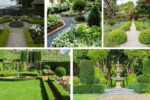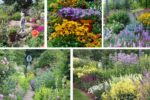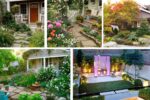A garden becomes truly enchanting when multiple design elements come together in harmony. One of the most captivating combinations is the pairing of water features with flower beds. Water in the garden—whether in the form of a pond, fountain, stream, or birdbath—naturally draws attention, while flowers bring vibrancy, fragrance, and seasonal change. When designed together, water features and flower beds not only enhance each other but also create a layered sensory experience: the sound of trickling water, the sight of vivid blooms, and the feel of fresh air all blending into a tranquil retreat.
Water feature flower beds are not only visually stunning but also practical, as they help frame the water source, provide habitat for pollinators, and even improve the microclimate around your garden. By carefully planning plant choices, layouts, and styles, you can double the effect of both elements and elevate your garden into a serene masterpiece.
Why Combine Water Features with Flower Beds?

- Enhanced Focal Point
- Water features already capture attention, but surrounding them with flower beds magnifies the visual impact and makes them the true centerpiece of the garden.
- Natural Integration
- Without flowers, water features can sometimes look stark or artificial. Flower beds soften hard edges and help blend water features into the landscape.
- Movement and Sound Balance
- Flowers provide seasonal movement with swaying stems and fluttering petals, complementing the soothing sound of moving water.
- Wildlife Attraction
- Water attracts birds, butterflies, and beneficial insects. Paired with flowering plants, these features become a hub for pollinators and small wildlife.
- Seasonal Beauty
- Water provides year-round interest, while flowers add changing color palettes across the seasons, ensuring the area never feels static.
Choosing the Right Water Feature

Before planting, it’s important to determine what type of water feature fits your garden and how flowers can complement it.
- Ponds: Perfect for lush, naturalistic flower beds. Pair with marginal plants like irises, water lilies, and moisture-loving perennials around the edges.
- Fountains: Best for formal gardens or small courtyards. Surround with symmetrical flower beds of roses, tulips, or boxwood borders.
- Streams and Rills: Ideal for creating a flowing, wild garden feel. Line the banks with native wildflowers, ferns, and ornamental grasses.
- Birdbaths: Compact yet charming. Accent with cheerful, pollinator-friendly flowers like coneflowers, zinnias, or marigolds.
- Waterfalls: Dramatic and dynamic. Pair with bold flowers like cannas, hostas, or hydrangeas for lush texture.
Design Principles for Water Feature Flower Beds

- Scale and Proportion
- Match the size of your flower bed to the water feature. A large pond can support wide, layered planting, while a small fountain looks better with compact flower borders.
- Planting Zones
- Use three layers for balance:
- Marginal plants near water edges (cattails, irises, marsh marigolds).
- Mid-height flowers slightly further away (daylilies, astilbes).
- Background plants for structure (ornamental grasses, shrubs).
- Use three layers for balance:
- Color Harmony
- Choose flower colors that reflect or contrast with the water feature:
- Blue or purple flowers near water enhance the calming effect.
- Bold oranges, reds, and yellows create dramatic contrast.
- Whites and pastels glow beautifully when reflected in water at night.
- Choose flower colors that reflect or contrast with the water feature:
- Seasonal Continuity
- Include bulbs for spring, perennials for summer, asters and mums for fall, and evergreens or ornamental cabbages for winter.
- Flow and Symmetry
- For formal fountains, use symmetrical planting. For natural streams or ponds, let flower beds flow in irregular, organic shapes.
Best Plants for Water Feature Flower Beds

Moisture-Loving Plants (great near ponds and streams)
- Japanese Iris
- Canna Lilies
- Hostas
- Marsh Marigold
- Astilbe
Pollinator Favorites (around birdbaths and fountains)
- Coneflowers
- Black-eyed Susans
- Bee Balm
- Zinnias
- Lavender
Ornamental Grasses and Texture Plants
- Miscanthus
- Pampas Grass
- Rushes
- Sedge
Seasonal Interest Plants
- Spring: Tulips, Daffodils, Primroses
- Summer: Daylilies, Hibiscus, Petunias
- Autumn: Asters, Sedum, Chrysanthemums
- Winter: Evergreen shrubs, Hellebores
Layout Ideas

- Circular Fountain Bed
- Place the fountain in the center. Surround with concentric rings of flowers, moving from low growers (alyssum, lobelia) to medium-height perennials (roses, salvias).
- Pondside Border
- Use tall reeds and grasses at the back, medium blooms like irises and coneflowers in the middle, and groundcovers such as creeping thyme at the water’s edge.
- Birdbath Nook
- Nestle a birdbath within a cozy flower bed of pollinator-friendly blooms. Add scented plants like lavender and thyme for a sensory retreat.
- Streamside Planting
- Allow native wildflowers and ornamental grasses to grow naturally along the stream, mimicking a meadow-like environment.
- Waterfall Backdrop
- Use bold, leafy plants like cannas, elephant ears, and hydrangeas to frame waterfalls, enhancing their dramatic look.
Lighting for Double the Effect
Adding light to water features and surrounding flower beds extends their beauty into the evening.
- Underwater Lights: Highlight fountains or pond edges, reflecting shimmering patterns onto nearby blooms.
- Spotlights: Illuminate a sculpture fountain surrounded by flowers.
- String Lights: Drape nearby trees or shrubs for a magical effect.
- Solar Garden Lights: Eco-friendly and perfect for outlining flower beds around water.
Maintenance Tips
- Water Quality
- Keep ponds and fountains clean to avoid algae, which can harm plants and reduce visual appeal.
- Pruning and Deadheading
- Regularly trim plants to prevent overgrowth that might hide the water feature.
- Soil Considerations
- Use moisture-retentive soil near ponds but ensure good drainage for flower beds near fountains.
- Wildlife Care
- Choose non-toxic plants around birdbaths and ponds to keep wildlife safe.
- Seasonal Adjustments
- Replace annuals seasonally to keep beds colorful and fresh.
Inspiring Combinations
- Fountain with Roses and Lavender: Formal elegance with fragrance.
- Pond with Water Lilies and Irises: Tranquil and naturalistic.
- Birdbath with Coneflowers and Bee Balm: Wildlife-friendly charm.
- Stream with Wildflowers and Grasses: Rustic, meadow-like appeal.
- Waterfall with Cannas and Hydrangeas: Tropical, lush drama.
Conclusion
Water feature flower beds are among the most enchanting garden designs, as they double the effect by combining two powerful visual and sensory elements. The water creates movement, sound, and reflection, while flowers add color, fragrance, and seasonal variety. Together, they create a layered garden experience that feels alive in every sense.
Whether you’re working with a grand pond, a modest birdbath, or a sleek modern fountain, the thoughtful addition of flower beds ensures your water feature becomes not just a focal point, but the heart of your garden. With the right design principles, plant choices, and maintenance, you can transform your outdoor space into a tranquil sanctuary that delights year-round.



